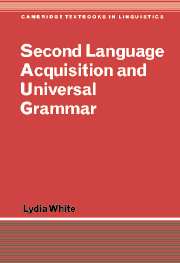Book contents
- Frontmatter
- Contents
- Preface
- Abbreviations
- 1 Universal Grammar and language acquisition
- 2 Principles of Universal Grammar in L2 acquisition
- 3 The initial state
- 4 Grammars beyond the initial state: parameters and functional categories
- 5 The transition problem, triggering and input
- 6 Morphological variability and the morphology/syntax interface
- 7 Argument structure
- 8 Ultimate attainment: the nature of the steady state
- Glossary
- Notes
- References
- Index
6 - Morphological variability and the morphology/syntax interface
Published online by Cambridge University Press: 05 June 2012
- Frontmatter
- Contents
- Preface
- Abbreviations
- 1 Universal Grammar and language acquisition
- 2 Principles of Universal Grammar in L2 acquisition
- 3 The initial state
- 4 Grammars beyond the initial state: parameters and functional categories
- 5 The transition problem, triggering and input
- 6 Morphological variability and the morphology/syntax interface
- 7 Argument structure
- 8 Ultimate attainment: the nature of the steady state
- Glossary
- Notes
- References
- Index
Summary
Morphological variability: identifying the problem
In several earlier chapters (chapters 3, 4 and 5), issues have arisen with respect to the relationship between interlanguage morphology and syntax, for example, presence or absence of verbal inflection and presence or absence of null subjects or of verb movement. There is considerable disagreement over the relationship between overt inflectional morphology and more abstract functional categories and their features, following similar disagreements in the field of L1 acquisition. In this chapter, we consider the morphology/syntax interface, discussing the extent to which morphology and syntax are interdependent in grammars in general, including interlanguage grammars. In particular, the implications of morphological variability will be addressed.
It is well known that L2 learners exhibit optionality or variability in their use of verbal and nominal inflection and associated lexical items. Morphology relating to tense, agreement, number, case, gender, etc., as well as function words like determiners, auxiliaries and complementizers, are sometimes present and sometimes absent in spontaneous production data, in circumstances where they would be obligatorily produced by native speakers. Furthermore, when morphology is present, it is not necessarily appropriate; certain forms are overused, occurring in contexts where they would not be permitted in the grammar of a native speaker.
Some of the earliest research on interlanguage concentrated on properties which we now recognize as being related to functional categories. (See Zobl and Liceras (1994) for an overview.)
Information
- Type
- Chapter
- Information
- Second Language Acquisition and Universal Grammar , pp. 178 - 202Publisher: Cambridge University PressPrint publication year: 2003
